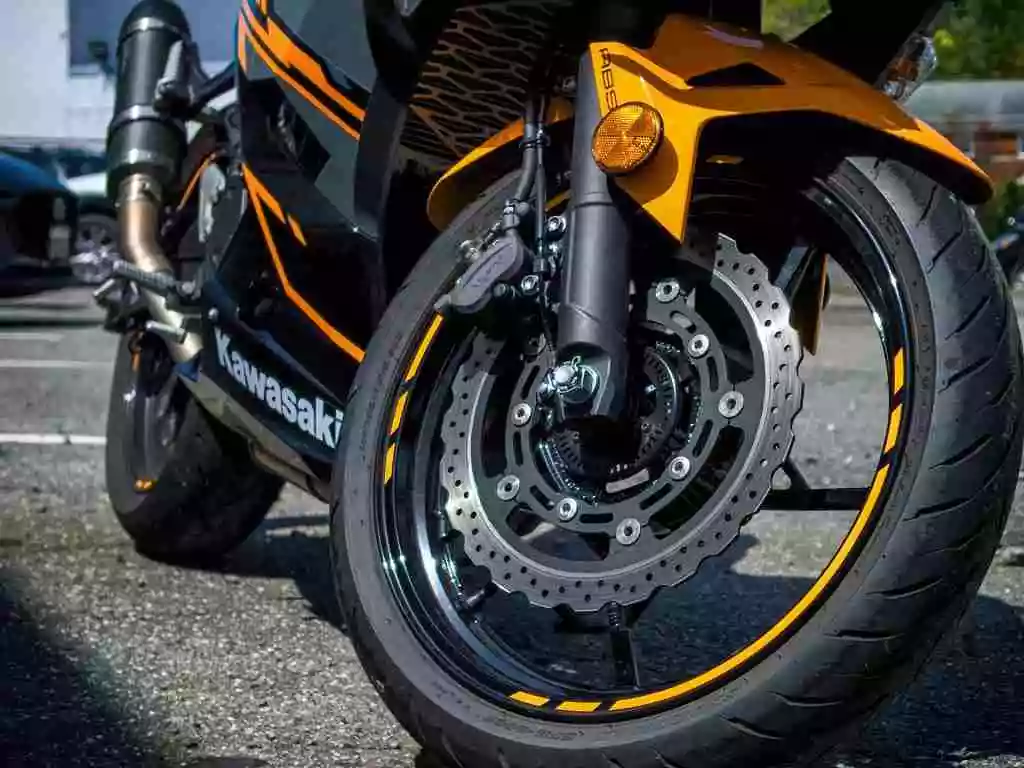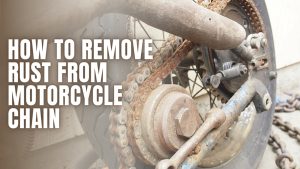As an Amazon Associate, we earn from qualifying purchases. We may get a commission when you purchase through our links, at no extra cost to you.
Nothing ruins a fun ride like a flat tire, am I right? I’m sure you’ve been there before – you’re cruising down the highway and suddenly you hit a pothole. Next thing you know, your bike is wobbling all over the place. Not fun!
Well, I’m going to share some tips to help prevent a flat motorcycle tire. You’ll be amazed by how easy it is to avoid flats once you know what to look out for.
5 Tips for Preventing a Flat Motorcycle Tire
Flat tires are the bane of any motorcyclist. They’re not only annoying, but they can also cause serious damage to your bike if they go unnoticed for too long.
We will discuss 5 tips that will keep your motorcycle tire happy and prevent sudden blowouts.
1. Inspect tires regularly for wear and damage
- Check tread wear and look for cracks/cuts in sidewalls
- Monthly checks are ideal to catch issues early
- Signs like uneven wear indicate need for replacement
You must inspect those tires regularly. I can’t stress enough how important it is to take a few minutes each month and check the tread. These are the things that connect your bike to the road, so make sure they’re in good shape.
Take a look at the tread depth – you wanna see at least 1/8 inch across the entire surface. Any less and it’s time to replace them. Check for any uneven wear too – if one section is balder than the others, it could mean your alignment is off.
And while you’re at it, give the sidewalls a once-over as well. Feel around for any bulges, cracks or cuts. Tires are the part most likely to sneak up on ya, so it pays to be diligent.
I’ve been caught a few times thinking “man, my tires sure seem low” only to realize later they were downright bald. Don’t be like me!
Set a reminder in your phone or calendar so you make those checks part of your regular routine. Fifteen minutes a month is so worth it to avoid getting stranded somewhere sketchy.
2. Maintain proper tire pressure
- Check pressure is at manufacturer’s recommended PSI
- Underinflated tires wear quicker and risk pinch flats
- Overinflated tires can be unstable and risk blowouts
Next up is keeping an eye on your tire pressure. Now this may sound boring, but it’s super important stuff. See, you wanna run your tires at the pressure the manufacturer recommends – it’ll be listed in your owner’s manual or on a sticker on the bike.
Why’s it so crucial? Well for starters, underinflated tires wear out much quicker. The extra flex puts more strain on the tread and sidewalls over time. It only gets worse if the pressure is really low, because then you risk pinch flats. Y’know, when the tire pinches down onto the rim under heavy braking or turning. No bueno!
On the other hand, overinflated tires aren’t much better. Sure, they’ll last longer tread-wise but handling can feel twitchy, and there’s a chance of a blowout at high speed. And have you ever had one of those happen? Scariest thing ever!
The correct settings for a motorcycle tire should be between 28 and 40 psi. Low temperatures decrease the pressure of tires. So, if you ride in a lot of colder temperatures or have heavy loads on your bike, then it might be necessary to increase the pressure by 5-10%.
The best way to keep your tires happy is with a digital gauge. They’re pretty cheap and let you get the pressure just right. Take 5 minutes to check once a week and you’ll be riding smooth for miles to come.

Slime 40061 Tire Inflator, Power Sport, Motorcycles, ATVs/UTVs and Cars
FEATURES WE LIKED
- Quick 12-minute tire inflation
- Safe for tire sensors
- Adapters for various inflatables
- Multiple power source connectors
3. Avoid road hazards
- Watch for debris, glass, nails, etc. on the road
- Slow down to minimize impact if hitting something is unavoidable
- Ride in tire tracks when possible
When you’re out riding it’s always important to keep an eye out for anything nasty that could mess up your day. Debris, glass, nails – that kind of junk gets thrown all over the place and it doesn’t take much to ruin your ride.
I always do a quick scan of the road ahead as I’m cruising. You never know what might be hiding around the next turn or over that hill. Little pieces of crap are one thing, but a 2×4 or chunk of tire? No thanks, I’ll spot that from a ways off if I can. Having a little more reaction time could save your bacon.
If you do see something and can steer around it safely, by all means do. But sometimes it’s unavoidable. No sense laying it down if you don’t have to though. If you’re gonna hit something, roll off that throttle and brake gently. The slower you’re going, the less damage it’ll do when you make contact. No need to highside over a pop can.
Stick to the tire tracks as much as possible. The middle of the lane is usually where the sweeper cleaned up last. Riding along the edges isn’t worth the risk of grabbing some mystery object.
4. Consider tire sealing products
- You can use temporary sealants like slime
- Still check tires regularly
We all know those punctures are no fun at all, so here are couple things you can do to help avoid getting stranded:
A lot of riders swear by those slime-type sealants. You know, the goop you dump in that’s supposed to temporarily plug little holes from screws or glass. I’ve used it before with some luck – got me home a few times when I hit something nasty. Just be sure to follow the instructions – some of that stuff is messy!

Slime 10011 Flat Tire Puncture Repair Sealant, Emergency Repair for highway vehicles
FEATURES WE LIKED
- Seals punctures up to 1/4″ instantly
- Works with an air source for emergency tire repair
- Sealant is carried directly to puncture source
- Safe and easy emergency repair up to 100 miles
Of course, the best thing is still checking your tire pressure and condition regularly. Give it a good visual once over whenever you’re gassing up to spot any odd bulges or cracks starting to form. Might save your back 50 miles down the road.
5. Riding technique matters
- Aggressive braking could cause pinch flats
- Sudden swerving puts stress on tires
- Smooth, controlled riding is best
A little riding technique know-how never hurt anything. We’re talking tires here, so listen up!
First thing – remember those tires have limits. If you jam on the brakes like a maniac, it can cause pinch flats real quick. The tire squishes out between the spokes and pops. Not a good way to end the day!
Same thing with swerving too hard. All that sideways G-force puts stress on the rubber. If it’s old tires, that can be all she wrote in a heartbeat. Had a buddy blow one out doing some crazy weaving once.
So do yourself a favor – ride within those tires’ abilities. Smooth inputs all around. Roll on the brakes gently and ease into turns. No need for heroics out there. Controlled is way better than crazy when you’re talking wear and tear.
Hell, you’ll probably have more fun that way too. Nothing ruins a ride like changing a tire on the side of the road! With a calm, steady riding style, you’ll get way more miles out of those tires.
The idea of a flat motorcycle tire is one that no rider wants to hear about, but it can happen. How you prepare for the unexpected will help keep your bike safe and in good shape. These tips will help you avoid flats by keeping an eye on tire pressure and taking other measures.
FAQs about Preventing a Flat Motorcycle Tire
What causes motorcycle tires to go flat?
Common causes of flat tires are nails, screws, and other sharp objects puncturing the tread; cracks or defects in the tire; and underinflated tires.
How often should I check motorcycle tire pressure?
Check your tire pressure before every ride. Cold tire pressure should match what’s recommended in your owner’s manual, typically between 28 to 40 psi for most motorcycles.
What’s the easiest way to prevent flat tires?
The easiest way is keeping tires properly inflated. Ensure tires are inflated to the correct cold pressure and check pressure regularly, especially before long trips.
Does tire sealant work for motorcycle tires?
Yes, tire sealant products like Fix-A-Flat can work for motorcycle tires to seal small punctures up to 3/16 of an inch. However, tire sealants are only a temporary fix and tires will still need to be replaced eventually.
Should I rotate motorcycle tires?
Rotating tires is not as critical for motorcycles as for cars since motorcycle tires wear more evenly. However, rotating tires every other oil change can help extend tread life, especially on touring bikes.
How thick should tread be on motorcycle tires?
Motorcycle tire tread depth of at least 3/32 of an inch is recommended. When tires reach 2/32 inch, they should be replaced to ensure adequate grip, especially in wet conditions.
What are the signs a motorcycle tire needs replacing?
Signs a tire needs replacing include uneven wear; visible cord or belt layers; significant cracking on sidewall; severe cupping or chunking of tread blocks; and obvious lump or bulge in the sidewall.




